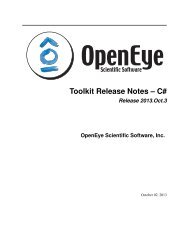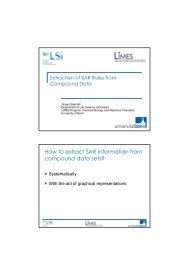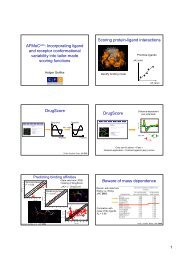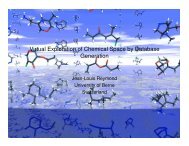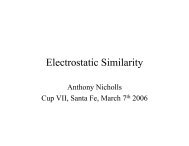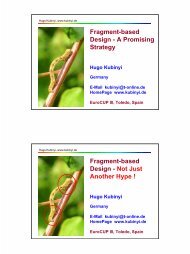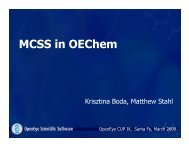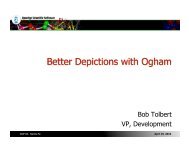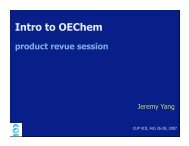OMEGA Release 2.5.1.4 OpenEye Scientific Software, Inc.
OMEGA Release 2.5.1.4 OpenEye Scientific Software, Inc.
OMEGA Release 2.5.1.4 OpenEye Scientific Software, Inc.
Create successful ePaper yourself
Turn your PDF publications into a flip-book with our unique Google optimized e-Paper software.
<strong>OMEGA</strong>, <strong>Release</strong> <strong>2.5.1.4</strong><br />
to be worse. At this writing, there is no known evidence to support this. Second, Lipinski used well-codified and wellunderstood<br />
yet imprecise definitions of “hydrogen-bond donors” and “hydrogen-bond acceptors” in his classification<br />
model. While this makes the algorithm quite understandable and easy to implement, it sometimes causes confusion<br />
with those who prefer more refined definitions of hydrogen-bond donors and acceptors.<br />
To address the first problem, users are allowed to set the number of Lipinski failures required to reject a molecule. In<br />
keeping with the original publication, the default value is 2. To address the second problem, two kinds of hydrogenbond<br />
donors and acceptors are calculated. In the Lipinski calculation, the published definitions are used (donor count<br />
is the number nitrogen or oxygen atoms with at least one hydrogen attached and acceptors are the number of nitrogens<br />
and oxygens). For calculation of the number of donors and acceptors in the molecule for the sake of chemical properties,<br />
a more complex algorithmic approach is taken. This approach identifies the donors and acceptors outlined in the<br />
work of Mills and Dean ([MillsDean-1996]) and also in the book by Jeffrey ([Jeffrey-1997]).<br />
See Also:<br />
The Lipinski violations and hydrogen-bond acceptors sections in the Filter Files chapter.<br />
11.7 Aggregators<br />
The Shoichet lab ([McGovern-2003], [Seidler-2003]) has demonstrated the importance of small-molecule aggregation<br />
in medium and high-throughput assays. Because these small-molecule aggregates can sequester some proteins, they<br />
give the appearance of being active inhibitors. There are now several hundred published aggregators in addition to a<br />
published QSAR model for predicting aggregation propensity. The user has the ability to eliminate any of the known<br />
aggregators as well as the ability to eliminate compounds that are predicted to be aggregators using the QSAR model.<br />
In <strong>OpenEye</strong>’s experience, the published QSAR model for predicting aggregators is quite aggressive. It occasionally<br />
identifies compounds that are known to be genuine small-molecule inhibitors of a specific protein. While in most cases<br />
this model can be useful, until more definitive work is published, we feel you should gain some experience with the<br />
model and judge its performance for yourself.<br />
More recent work in industry indicates that in some cases, aggregation properties are specific to the particular experimental<br />
conditions being used. Thus we recommended caution in the interpretation of these predictions. Nevertheless,<br />
aggregation remains an important issue in HTS hit follow-up and, short of experimental validation, this flag may be<br />
the best-available.<br />
See Also:<br />
The aggregators parameter in the Filter Files chapter.<br />
46 Chapter 11. Molecular Properties and Predictors



